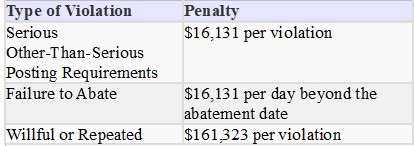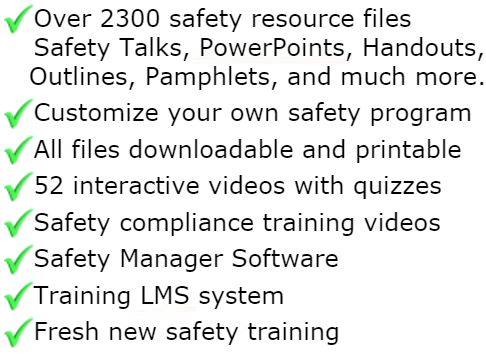
Emergency Response Planning
OSHA requires each employer to have a site specific employee emergency response plan. Workplace safety requires a clear evacuation plan and other systems and trainings to ensure workplace safety and adequate emergency response plan.
A risk management plan is required by the EPA if your workplace stores or uses highly hazardous chemicals and materials. First responder training is required for any workers who as tasked with controlling a chemical emergency. Incident emergency response planning includes development, training and implementation of an incident command structure to ensure a safe and coordinated response to any emergencies.
First Responders & Emergency Response Plans?
Management should review plans with employees initially and whenever the plan itself, or employees responsibilities under it, change. Plans should be re-evaluated and updated periodically. Emergency procedures, including the handling of any toxic chemicals, should include:
• Escape procedures and escape route assignments.
• Special procedures for employees who perform or shut down critical plant operations.
• A system to account for all employees after evacuation.
• Rescue and medical duties for employees who perform them.
• Means for reporting fires and other emergencies.
• Contacts for information about the plan.
An emergency response coordinator and a back-up coordinator must be designated. The coordinator may be responsible for plant-wide operations, public information and ensuring that outside aid is called in. A back-up coordinator ensures that a trained person is always available alert.
Members of emergency response teams should be thoroughly trained for potential emergencies and physically capable of carrying out their duties; know about toxic hazards in the workplace and be able to judge when to evacuate personnel or depend on outside help.
Effective emergency response communication is vital. An alternate area for a communications center other than management offices should be established in the plans and the emergency response coordinator should operate from this center. Management should provide emergency alarms and ensure that employees know how to report emergencies. An updated list of key personnel and off-duty telephone numbers should be maintained.
A system should be established for accounting for personnel once workers have been evacuated with a person in the control center responsible for notifying police or emergency response team members of persons believed missing.
Effective security procedures, such as cordoned off areas, can prevent unauthorized access and protect vital records and equipment. Duplicate records can be kept in off-site locations for essential accounting files, legal documents and lists of employees relatives to be notified in case of emergency.
Every employee needs to know details of the emergency action plan, including evacuation plans, alarm systems, reporting procedures for personnel, shutdown procedures, and types of potential emergencies. Drills should be held at random intervals, at least annually, and include, if possible, outside police and fire authorities.
Training must be conducted initially, when new employees are hired, and at least annually. Additional training is needed when new equipment, materials, or processes are introduced, when procedures have been updated or revised, or when exercises show that employee performance is inadequate.
Emergency Plan & Hazardous Chemical Response Basics
What chemical emergencies are:
Where hazardous chemicals come from
Some chemicals that are hazardous have been developed by military organizations for use in warfare. Examples are nerve agents such as Sarin and VX, mustards such as sulfur mustards and nitrogen mustards, and choking agents such as phosgene. It might be possible for terrorists to get these chemical warfare agents and use them to harm people.
Many hazardous chemicals are used in industry (for example, chlorine, ammonia, and benzene). Others are found in nature (for example, poisonous plants). Some could be made from everyday items such as household cleaners. These types of hazardous chemicals also could be obtained and used to harm people, or they could be accidentally released.
Types and categories of hazardous chemicals
Biotoxins—poisons that come from plants or animals
Blister agents/vesicants—chemicals that severely blister the eyes, respiratory tract, and skin on contact
Blood agents—poisons that affect the body by being absorbed into the blood
Caustics (acids)—chemicals that burn or corrode people’s skin, eyes, and mucus membranes (lining of the nose, mouth, throat, and lungs) on contact
Choking/lung/pulmonary agents—chemicals that cause severe irritation or swelling of the respiratory tract (lining of the nose and throat, lungs)
Incapacitating agents—drugs that make people unable to think clearly or that cause an altered state of consciousness (possibly unconsciousness)
Long-acting anticoagulants—poisons that prevent blood from clotting properly, which can lead to uncontrolled bleeding
Metals—agents that consist of metallic poisons
Nerve agents—highly poisonous chemicals that work by preventing the nervous system from working properly
Organic solvents—agents that damage the tissues of living things by dissolving fats and oils
Riot control agents/tear gas—highly irritating agents normally used by law enforcement for crowd control or by individuals for protection (for example, mace)
Toxic alcohols—poisonous alcohols that can damage the heart, kidneys, and nervous system
Vomiting agents—chemicals that cause nausea and vomiting
Protecting yourself if you don't know what the chemical is
You could protect yourself during a chemical emergency, even if you didn't know yet what chemical had been released. For general information on protecting yourself, read this Web site's fact sheets on evacuation, sheltering in place, and personal cleaning and disposal of contaminated clothing for assistance with an emergency response plan..
Emergency response or responding to emergencies is an effort by employees from outside the immediate release area or by other designated responders to an occurrence which results, or is likely to result, in an uncontrolled release of a hazardous substance. Responses to incidental releases of hazardous substances where the substance can be absorbed, neutralized, or otherwise controlled at the time of release by employees in the immediate release area, or by maintenance personnel are not considered to be emergency responses within the scope of this standard. Responses to releases of hazardous substances where there is no potential safety or health hazard (i.e., fire, explosion, or chemical exposure) are not considered to be emergency responses.
Hazardous materials response (HAZMAT) teams, as part of an emergency response plan, are an organized group of employees, designated by the employer, who are expected to perform work to handle and control actual or potential leaks or spills of hazardous substances requiring possible close approach to the substance. The team members perform responses to releases or potential releases of hazardous substances for the purpose of control or stabilization of the incident. A HAZMAT team is not a fire brigade nor is a typical fire brigade a HAZMAT team. A HAZMAT team, however, may be a separate component of a fire brigade or fire department.
Health hazards can be from chemicals mixture of chemicals or a pathogen for which there is statistically significant evidence based on at least one study conducted in accordance with established scientific principles that acute or chronic health effects may occur in exposed employees. The term "health hazard" includes chemicals which are carcinogens, toxic or highly toxic agents, reproductive toxins, irritants, corrosives, sensitizers, hepatotoxins, nephrotoxins, neurotoxins, agents which act on the hematopoietic system, and agents which damage the lungs, skin, eyes, or mucous membranes. It also includes stress due to temperature extremes.
Post emergency response is that portion of an emergency response performed after the immediate threat of a release has been stabilized or eliminated and clean-up of the site has begun. If post emergency response is performed by an employer's own employees who were part of the initial emergency response, it is considered to be part of the initial response and not post emergency response plans.
All materials in the members area for this topic index

GET INSTANT ACCESS
to THE MEMBERS LIBRARY
Safety materials created by safety professionals.
Access to the Safety Manager software.
Wide variety of safety videos and courses.
**Brand New** Safety Training Management System
Pre-Made Safety Materials Ready For Use
Created by experienced safety professionals & risk consultants. Saving you time, money, and risk of injuries.
95% of the work already done.
Below are the maximum penalty amounts, with the annual adjustment for inflation, that may be assessed after Jan. 15, 2024. (See OSHA Memo, Jan. 8, 2024).

**New OSHA HEAT 90 DAY**
>>Download Free HERE<<
**New 2024 OSHA 300 Form**
>>Download Free HERE<<
**Brand New**
Free with full membership subscription
Training LMS System
Ask The Safety Consultant
Safety Equipment Deal Finder

“SafetyInfo.com is the first go-to website for safety professionals and companies to use in establishing a solid safety program"
-Mike McKenzie, Certified Safety & Health Manager (CSHM), McSafety Solutions™
Note: You must have a full subscription to the Safety Library in order to use this material. Any use outside of your organization, for resell, or without an active membership is strictly prohibited and may result in prosecution under copyright infringement laws. Please contact us first, if you would be interested in reselling or using our materials for reproduction.
Inside the Members Library
Topic Index
Accident Prevention
Air Quality
Asbestos
Bloodborne Pathogens
Boilers
Chemical Safety
Compressed Gas
Confined Space
Construction
Construction Worksite
Cranes & Slings
Driver / Fleet Safety
Drug Free Workplace
Electrical
Emergency Management
Engineering Safety
Environmental
Equipment
Ergonomics
Fall Protection
Fire Safety & Prevention
First Aid
Flammable Materials
Forklifts
Hazard Communication
Hazardous Materials
Hearing Protection
Heat Stress
Hot Work
Housekeeping
Job Safety Analysis
Laboratory
Ladders
Lead
Lockout-Tagout
Machinery & Equipment
Material Handling
MSDS (SDS)
Medical & First Aid
Occupational Health
Office Safety
Off the Job Safety
Personal Protection
Process Safety
Record Keeping
Respiratory Protection
Silica Safety
Rules & Policies
Signs & Labels
Slips, Trips & Fall
Training
Terrorism Programs
Tool Safety
Vehicle & Driver
Violence Programs
Welding & Hot Work
Training Videos
Library Index
Training Materials
Videos/Courses
Talks
Articles
PowerPoint
Handouts
Training Overheads
Quizzes
Supervisor Briefs
Management Briefs
Safety Sessions
2 Minute OSHA Safety Talks
Pamphlets
First Aid Training
Supervisor Training
Hazardous Materials
Bomb Threat
Crossword Puzzles
Biological Agents
Forms & Documents
Forms
Checklists
Audit Guides
Inspections Guides
Signs & Labels
Environmental Audit Guides
Recordkeeping - OSHA 300
Sign & Label Maker
Safety Management Resources
Safety Manuals/Written Programs
Ergonomic Programs
Emergency Plans
Process Safety Management
Construction Safety
Occupational Health
Environmental
Topic Sheets
DOT Fleet-Driver
Hazardous Materials
Chemical Safety
Drug Free Workplace
Terrorism Programs
Development Guides
Safety Manager Software
Safety References & Graphics
Technical Safety Information
Posters
Topic & Fact Sheets
Development Information
Job Specific Safety Rules
Terrorism
Calculators
Safety Comic Strips
New Safety Training System
Schedule and train your employees with our materials. Add unlimited amount of employees. Record all progress and issue certificates. For group and individual training sessions.

